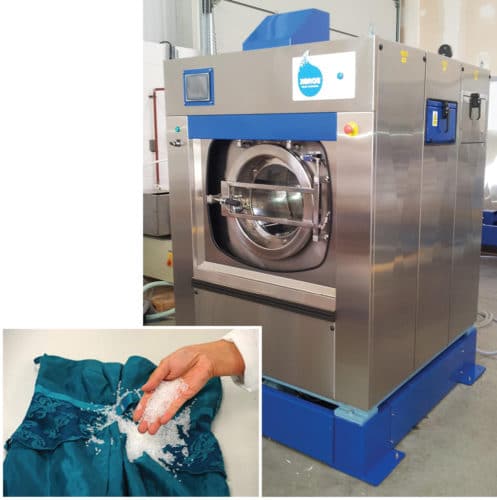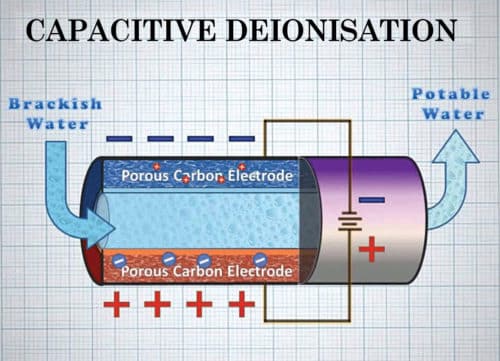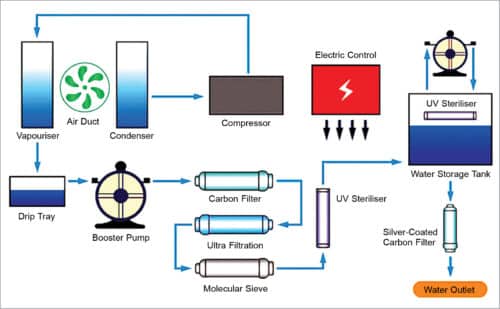In recent times, several electronic devices, which are being developed to improve potable water availability, are becoming a part of the market and households. This article discusses different ways of using electronics to clean, produce or conserve water.
Water is one of the most precious ingredients for life, but with a growing population, changing environmental conditions and changing lifestyles, potable water crisis is a reality all over the world. Only humans, among other living species that need water, are misusing potable water and its resources for such tasks as bathing and washing.
Clean and safe drinking water is a challenge for the growing global population and for millions of people around the world. To further complicate existing and increasing issues with supply, 85 per cent of diseases in the world are transmitted through non-potable water. The problem is represented below.
- About 2.1 billion people around the world live without access to safe drinking water.
- About 1.7 million children die annually due to lack of clean drinking water.
- About 443 million school days are lost annually due to water-related diseases.
- About 50 per cent of the world’s population will live in water-stressed areas by 2025.
It is common knowledge that water destroys electronics and so the two do not go well together. But electronics has a number of applications for water, related to water conservation through water-level indicators/controllers, moisture sensing, waterless washing, water cleaning and purification, desalination and even generating water from air.
Growing scarcity of potable water all over the world, in general, and in many parts of India, in particular, needs the use of electronics—the present tool for everything—not only for water cleaning (waste water treatment or purification/desalination) and conservation, but to also make it fresh using renewable sources available on earth and in the atmosphere in meaningful quantities.
A solution is possible if a large quantity of potable water can be generated economically and in an environmental-friendly manner using electronics. So far, it has been a common belief that the global electronics industry has been slow to make large-scale innovative strides that address the use of electronics in dealing with potable water scarcity. However, in recent times, several electronic devices, which are being developed to improve potable water availability, are becoming a part of the market and households.
Water sensing
Applications of electronics in water-level indicators, controllers, switches and probes are already in play. Devices such as electronic level controllers, level sensors, water-level alarms, float switches and other types of water-level controllers have become an integral part of every household, and are helping in the conservation of water by controlling water wastage.
The electronic water-sensing system first senses the amount of water available in the water reservoir using the level detector and then adjusts state of the water pump in accordance with the water level. It achieves automation through sequential logic implemented using flip-flop circuits. A display and relay-based motor pump driving circuit are part of the integrated design. The pump automatically opens and stops for filling and emptying water.
Waterless washing
A waterless washing machine is being developed with the hope that it will stop water wastage. The washing machine’s system is based on University of Leeds’ Prof. Stephen Burkinshaw’s research, which focuses on the structure of nylon polymer beads, because nylon is the best material for absorbing tiny particles.

He, along with his team of researchers, have come up with the concept of using nylon to remove stains from clothes. They have partnered with Xeros Ltd to produce waterless washing machines for commercial use. Currently, this technology is available at a small scale, but efforts are being made to scale it up and create a household version soon.
Another concept has been introduced by designer Elie Ahovi, which uses the principle of magnetic levitation. The new device consists of a spherical drum that cleans clothes by scrubbing them using dry ice, instead of water. The drum is essentially a ring filled with batteries, which produces magnetic levitation inside the ring and levitates the super-conductive metal laundry basket inside.
A low temperature is required inside the ring, which is produced by using liquid nitrogen. The entire process is controlled using a touchscreen interface. Dry ice, introduced inside the ring at supersonic speed, hits dirty clothes, and carbon-dioxide generated interacts with dirt and separates it from the clothes.
Dirt is then collected and filtered out through small pores, and carbon-dioxide is removed and re-frozen. This is how clothes are cleaned and dried.
Water purification
Electronic water purification enables users anywhere to convert readily-available but polluted non-salty water to potable water, at a fraction of the cost of bottled water. The system ensures that water that is used in business, industry and at home is safe to use.

The electronic water purification technology uses electromagnetism to rid water of impurities. The science behind the system is relatively straight-forward.
The electronic water purification method works by applying DC power to carbon-based electrodes, which are layered into a casing. Application of this power causes the electrodes to be charged with opposing polarity. This opposing polarity attracts minerals present in the water, removing them from water. Minerals are absorbed on the surface of the electrodes, which causes all minerals and impurities to be removed, leaving behind nothing but pure water. When these contaminants build up, they are simply dumped by reversing the polarity of the charge and then flushed away by a valve system.
Relatively cheap to purchase, install and maintain, the electronic water purifier is convenient and affordable to use. Whereas, other systems can be expensive and complicated. Because the electronic water purifier does not rely on high pressures to work, power requirements are low, making it efficient. It can even be used with a solar power system.
A high percentage of water is recovered, which makes the system more efficient than many other water purification technologies. The electronic water purifier requires no chemicals to operate, making it easy and safe to use. It easily removes more contaminants from water than other technologies, including total dissolved solids (TDSes), lead, nitrates, metals, perchlorate, sodium-chloride, sulphates, calcium and arsenic.
Since it can rid the water of contaminants that are potentially harmful, the electronic water purifier can be used to provide safe and clean drinking water for homes and businesses, as well as softening water for use in and around households for other tasks.
The electronic water purifier can also be used in a variety of commercial, industrial and large industry settings. Aside from the huge benefits of using green technology, the equipment is extremely cost-effective.
Water desalination
Desalination refers to any process for removing excess salt and other minerals from salty water to get potable water. Electronics-based water desalinations technologies are cost-effective, compact, modular, portable, efficient and reliable. Some water desalination technologies based on the principles of electronics are discussed next.
Electrochemical mediation
This method of desalination of seawater makes use of capacitive or battery electrodes that consume less energy, and is dramatically simpler than conventional techniques. It works by creating a small electric field that removes salts, and the process evades the bottlenecks confronting current desalination methods based on the use of membranes.
Called electrochemically-mediated seawater desalination, the technique requires so little energy that it can run on a store-bought battery. To achieve desalination, the user applies a small voltage (3V) to a plastic chip filled with seawater. The chip contains a micro-channel with two branches. At the junction of the micro-channel, an embedded electrode neutralises some of the chloride ions in salty water to create an ion-depletion zone, which increases the local electric field in comparison to the rest of the channel.
This change in the electric field is sufficient to allow salt to pass into one branch and desalinated/pure water to pass through another. Neutralisation reaction occurring at the electrode is the key to removing salts from seawater.
Shock-wave electrodialysis
This system uses an electrically-driven shockwave within a stream of flowing water, which pushes salty water to one side of the flow and freshwater to the other. It looks similar to conventional electrodialysis but is fundamentally different. In this process, water flows through a porous material sandwiched between membranes or electrodes on each side. With increased current through the system, salty water gets separated into two zones of high and low concentrations of salt. When current is increased to a certain limit, it generates a shock-wave between two zones, sharply dividing the water streams, and allowing fresh and salty waters to be separated by a simple physical barrier at the centre of the flow.
Using solar cells
Researchers hope to use a mechanism to manufacture a device that would directly desalinate saltwater upon exposure to sunlight. In this direction, they so far have achieved success by allowing salty water to pervade through two ion-exchange membranes. Here, one membrane mostly transports positively-charged ions (cations) like protons and other negatively-charged ions (anions) like hydroxides. The membranes function as a pair of chemical gates to achieve charge separation.
Further, shining a laser light on the system prompts light-sensitive organic dye molecules bound to the membranes to liberate cations, which are then transported to the more acidic side of the membrane. This produces a measureable ionic current and voltage of over 100mV.
Despite crossing 100mV photovoltage threshold at times, the level of electric current that the double-membrane system can achieve remains its chief limitation. Thus, photovoltage being generated would need to be increased to reach a level of 200mV necessary to desalinate seawater.
Using batteries
Scientists are inspired by the working principle of sodium-ion batteries, which contain saltwater. The technology that charges the batteries could provide fresh water from salty seas as electricity running through a saltwater-filled battery draws salt ions out of water.
A battery has two chambers—positive electrode and negative electrode, with a separator in between that the ions can flow across. When it discharges, sodium and chloride ions—the two elements of salt—are drawn to one chamber, leaving desalinated water in the other. In a normal battery, ions diffuse back when current flows in the other direction, but researchers have to find a way to keep salt out of the now-pure water.
Water from air
With the impact of climate change making ground and surface water more scarce, companies are looking to tap the atmosphere that holds 37.5 million billion gallons of water, calling it water from air. This is higher than the approximately 32.6 million billion gallons of freshwater—the rest is locked up in ice-caps and glaciers—present on earth.
Two primary techniques to extract water from air are based on cooling and use of desiccants. Pulling water out of the atmosphere requires significant input of energy; however, some atmospheric water-generation methods are completely passive, relying on natural temperature differences and requiring no external energy source.

Most atmospheric water generators that make water from air operate in a manner similar to a dehumidifier. In a dehumidifier, air is passed over a cooled coil, causing the water to condensate. Rate of water generation depends on ambient conditions of temperature and humidity, along with volume of air being passed over the coil as well as capacity of the machine to cool the coil.
As a consequence, such systems reduce air temperature, which, in turn, reduces air’s capacity to carry water, lowering water production. Atmospheric water generators are designed for towns, villages, factories, off-grid settlements and communities. These can also be used to provide drinking water in community centres and public places like healthcare centres, schools, colleges, offices, railway stations, bus stands, airports, seaports, off-shore oil rigs, military establishments, remote field areas and establishments, and residential complexes.
While the concept is not new in the US, Europe and the Middle East, the technology—which works well in coastal areas where humidity is high—is yet to achieve scale in India. Along with companies like Watergen (an Israeli company), progressing well in generating water from air, Mumbai-based WaterMaker (India) Pvt Ltd, Kolkata-based AKVO, Hyderabad-based Skywater Pvt Ltd and Bharat Electronics Ltd (BEL) have also developed different models of atmospheric water generators with the purpose to condense moisture in the atmosphere into water.
Water is then filtered and purified through several filters, including carbon, reverse osmosis and UV sterilisation lights, to produce pure drinking water. It is expected that the magic of being able to pull water out of thin air will soon become a reality. Watergen has recently unveiled a water generator for the average consumer using a simple plug-and-play technique, which will turn air into water.
In the end, it is worth mentioning that electricity and fossil fuels are not the only ways to power atmospheric water generators; solar power is another energy-efficient option.
Dr S.S. Verma is professor at Department of Physics, Sant Longowal Institute of Engineering and Technology, Sangrur, Punjab.










